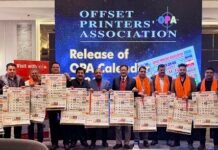This month, before our annual issue of the fifty fastest growing newspapers of 2013-2014 we are highlighting twenty of the biggest newspapers in India, each with a circulation exceeding a million copies, and a combined circulation exceeding 40 million. Among the most read newspapers are the English and the Hindi newspapers followed by Malayalam, Marathi, Tamil,
Telegu, Bengali and Gujarati, dailies most of which are still on a high growth path.
India is one of the few nations in the world where twenty plus newspapers are selling in excess of a million copies in print. With a population of a 1.2 billion people, and a moderate literacy rate of around 75% that is climbing by the day, and less than 300 million newspaper readers, the nation with the largest paid circulation of newspapers in the world, has still a long way to go.
Cross country growth
Bennet Coleman (BCCL) is the largest newspaper group with its flagship English daily the Times of India alone having a circulation of 4 million plus. The next biggest are the Hindi language papers the Dainik Jagran and the Dainik Bhaskar each claiming a circulation of over 3.5 million closely followed by Rajasthan Patrika claiming a circulation sales of 3.2 million copies daily. The Hindustan, the Hindi language paper of Hindustan Media Ventures follows strongly with a circulation of 2.4 million while the Birla group’s English daily The Hindustan Times has a circulation of
1.7 million. Amar Ujala another Hindi language daily scores high with daily sales of 2.1 million copies.
The Malayalam daily Malayala Manorama has a circulation of over 2.3 million while its closest competitor Mathrubhumi sells over 1.4 million copies daily. The next big market for newspapers is Tamilnadu where The Hindu the English language daily of Kasturi and Sons with a circulation of
1.4 million and three Tamil newspapers hits the mark. The Daily Thanthi sells over 1.5 million copies while Dinakaran sells over 1.2 million copies, and Dinamalar touches a
million. Another strong centre among Indian language papers is Andhra Pradesh now divided into the states of Telengana and Seemandhra. Here the Telegu paper Eenadu with 1.8 million copies and Sakshi with 1.4 million plus copies rule the roost followed by the English daily Deccan Chronicle that had crossed 1.3 million copies during its heydays in 2012 before the over borrowed parent company got sued by the bankers.
The political satraps of Congress NCP combine control the Marathi language dailies dominated by Lokmat and Sakal selling over 1.5 million copies each. Bengali has the Ananda Bazar Patrika selling 1.2 million plus copies while the Gujarat market has its heavyweights with Gujarat Samachar at
1.4 million copies and Divya Bhaskar the Gujarati language daily of the Bhaskar group just touching the
circulation mark of 1 million.
BCCL grows the fastest
The diversified Bennet Coleman group is India’s biggest media group with presence in print, internet and television. The group has placed its faith firmly with two major press suppliers. In the metros and high production centres like Mumbai, Delhi NCR, Kolkata, Chennai and Bengaluru it has gone with manroland while in the smaller cities like Ahmedabad, Chandigarh and Nagpur it has chosen Manugraph Newsline presses. Similarly in the mailroom systems it has Ferag as its firm favourite in the bigger cities while Wamac conveyors find favour where the smaller units are located. During 2012 manroland installed its 4 x 1 compact
modular press for TOI at Pune making a breakthrough in the medium range segment in non-metros. The advent of the simplified, light weight, smaller height 4 x 1 presses with smaller cut off and capable of running without air- conditioning and meeting frequent power outages at the tier-2 and tier-3 cities could be the future trend in India.
Headed by Vineet Jain this family- owned professionally managed company is the most aggressive amongst newspaper groups. A decade ago it was primarily dominant in western India trying to establish its foothold in northern India where HT Media’s Hindustan Times was the undisputed leader. Today TOI is the
largest selling newspaper in both Mumbai and Delhi and the group has made new inroads in Kolkata, Bengaluru and Chennai where ABP’s The Telegraph and KSL’s The Hindu have been the traditional favourites.
However, while its flagship brand TOI has moved ahead fast, its business paper The Economic Times has lost ground to the Mint of the HT Media and its Indian language papers have been pretty listless in face of aggressive growth of Hindi language newspapers. The gap of advertisement tariff between English and Indian languages have reduced substantially throughout India, though TOI still commands a premium.
The big boys of Hindi heartland
The populous north Indian landscape has been dominated by Jagran and Bhaskar, two groups each circling the other like boxing pros without directly punching the other. Dainik Jagran dominates all of UP, India’s most populous state that is bigger than any European nation with the exception of Russia. It also has a big circulation in the North Indian states of Punjab, Haryana, Himachal Pradesh, Delhi NCR and Jammu besides a small part of Jharkhand, Bihar, Maharashtra and Gujarat. The organization is managed by CMD MM Gupta and his sons. It has newspapers in four Indian languages
— Hindi, Urdu, Punjabi and Gujarati
with a total circulation of 5.5 million and its flagship Hindi newspaper Dainik Jagran sells 3.5 million copies daily. While Manugraph Cityline is the favoured press for this group, most of the postpress conveyors are provided by MM Technologies.
Dainik Bhaskar Group renamed as DB Corp has now diversified into FM radio stations, real estate and the energy industry and is managed by chairman Ramesh Chandra Agarwal and MD Sudhir Agarwal. Dominant in central and western parts of India namely MP, Haryana, Rajasthan, Maharashtra, and Gujarat this group has Hindi, Marathi and Gujarati newspapers with 65 editions in the 7 states and a total circulation of 5.5 million and has made its maiden entry in Bihar with a Patna edition early this year.
This group has assorted presses probably because it also has interests in the commercial printing business. It has Indian presses of Manugraph, TPH Orient, RMPL and Prakash, besides foreign brands like KBA Prisma, Komori and Mitsubishi. Two newspapers of the group the Hindi paper Dainik Bhaskar with a circulation of 3.5 million and the Gujarati daily Divya Bhaskar with a circulation of million copies are part of this exclusive club of million plus newspapers.
Snapping on the heels of the big two is the Gulab Kothari led Rajasthan Patrika with 32 editions in 8 states and a circulation of over 3.2 million. It is one of the few major newspaper groups who have been buying reconditioned 4 x 2 presses in the past but has recently installed one Manugraph M360 press at Bhopal.
The fourth major player in North India is the HT Media group managed by Shobhna Bharatia with the help of professional managers, which also has two players of the club million. The Hindi paper Hindustan with a circulation of 2.4 million copies and the English paper The Hindustan Times with sales of 1.7 million copies daily form the core of the group that has also presence in television and multi media. Here again it is manroland at the metros and Manugraph and TPH Orient presses at the smaller cities. In the past year HT Media has also installed ten 4 x 1 towers from TKS at its mother plant in Greater Noida. HT Media also has a commercial printing plant with several heat set presses and a multicolor Manroland Sheetfed printing magazines and books
as well as the group’s Berliner format tabloid The Mint.
Amar Ujala another strong player in the Hindi heartland managed by the Maheshwari family has a circulation of 2.1 million primarily from UP, Delhi NCR, Himachal, Uttaranchal and Jammu. Here it is TPH orient single width presses that rule the roost with postpress conveyors provided by Technicon.
The southern giants
Kerala one of the smallest Indian states is the home of highest newspaper readership in India thanks to its 94% literacy rates. Here Malayala Manorama is the undisputed leader with 2.3 million readers way ahead of second place Mathrubhumi.
The Mammen Mathew led Malayala Manorama is incidentally India’s largest producer of magazines with Vanitha, Manorama Weekly and The Week along with half a dozen other publications clocking up over 2 million in magazine circulation sales.
The Kerala market is extremely competitive and has been a stronghold of Manugraph and other single width press suppliers, though Manorama is also the first customer of the Manugraph 4 x 1 press. The Sreyams Kumar led Mathrubhumi with
1.4 million circulation has 14 editions and a dozen publications. Three years ago Mathrubhumi purchased a brand new TKS 4 x 1 line with its Ferag mailroom for its new plant near Thiruvananthapuram and ordered 10 Ferag mailroom systems for its plants around the state.
Manorama after its initial purchase of several Manugraph 4 x 1 presses also bought 3 reconditioned presses as a stop gap arrangement a few years ago. It is now expanding with five 4 x 1 Mitsubishi DiamondSpirit SA new generation lightweight presses with five Muller Martini mailroom systems that are to be installed serially beginning last quarter of 2014.
Kasturi and Sons has been the first and the biggest buyer of these
Mitsubishi DiamondSpirit 4 x 1 presses. The Hindu has installations at all its printing centres of these state-of- the-art presses while some of its smaller circulation plants use Manugraph high speed single width presses. There mailroom purchases recently sprung a surprise as they opted for a competitive Seiken mailroom that was operational during the KSL Mitsubishi open house held post Wan-Ifra conference at Bengaluru last year. KSL traditionally had a reputation to chose technology over price.
However, with Malayala Manorama installing the Misubishi DiamondSpirit SA presses there are clear signals that they are now becoming more affordable and focused on Indian market.
The other big players in Tamilnadu are the Daily Thanthi the Tamil paper with sales of over 1.5 million copies and Dinakaran with circulation of 1.2 million copies and Dinamalar touching a million copies. The Seiken 65 is the favoured model for presses at the Daily Thanthi with Seiken as well as Ferag conveyor systems finding place in postpress, while Manugraph is the favourite at Dinamalar, having completed its 16 th installation at its premises. While Balasubramanian Adithan heads the Daily Thanthi group, Dinakaran is headed by Kalanidhi Maran of the DMK, while Dinamalar is managed on a day-to-day basis by V Adimoolam, director technical.
The Ramoji Rao controlled Eenadu is the undisputed leader in the Telegu newspaper segment and has diversified interests. The Eenadu group has been the other major newspaper group successfully moving forward with reconditioned presses. Starting out with Priya Pickles this media mogul today owns newspaper, film studios and real estate.
A controversial entity of the Indian media industry is Deccan Chronicle of the Venkattram Reddy group that is now in deep trouble with prominent banks suing it for unpaid debts. It had a daily circulation of above 1.3 million in 2012 though critics accused it of ‘Raddi economics’— printing unsold copies to boost circulation figures. It is printed from Hyderabad, Chennai and Bengaluru and has Goss and Uniliner presses and Ferag post press conveyor systems. The Sakshi is another major
competitor in the region
headquartered at Hyderabad with 19 editions and a circulation of 1.4 million and is managed on a day-to-day basis by V Murali executive director.
The West and the East
The NCP and Congress control the Marathi language newspapers market driving the BCCL controlled Maharashtra Times to a distant third. Sakal Media is controlled by the NCP’s Pawar clan and managed by Abhijit Pawar while the Lokmat group is controlled by Congress MP Vijay Darda. Both groups have circulation exceeding 1.5 million with clear area segmentation. While Sakal is more dominant in the Pune belt, Lokmat is more spread out over Maharashtra in Nagpur, Nashik, Jalgaon and Aurangabad. Both groups have relied heavily on Manugraph and TPH orient presses with Schur, Technicon and assorted post press conveyor systems.
The Gujarat heavyweights are the
`2,000 crore Gujarat Samachar managed by Shreyansbhai and Bahubalibhai Shah with a circulation of 1.4 million and DB Corps Divya Bharati that crossed the million daily mark last year. The sole player in the million plus club from eastern India is the Ananda Bazar Patrika owned by Aveek Sarkar and managed by DD Purkayastha. With a circulation of 1.2 million this Kolkata-based Bengali language daily has Goss, Manugraph
and Wifag printing presses and Ferag
postpress conveyors.
Importantly each of India’s newspaper industry giants are investing in new presses and pre and postpress equipment and are growing at over 5% growth rate besides maintaining a healthy bottomline.
This is pretty unique considering that digital growth of the newspaper industry and cross media growth is
also happening in India besides growth in print circulation, color pages and advertisement revenue. No wonder the big web offset press makers like manroland and Mitsubishi are bending their back to make smaller and lighter presses for the mid-segment consumers from the Asian markets.

















